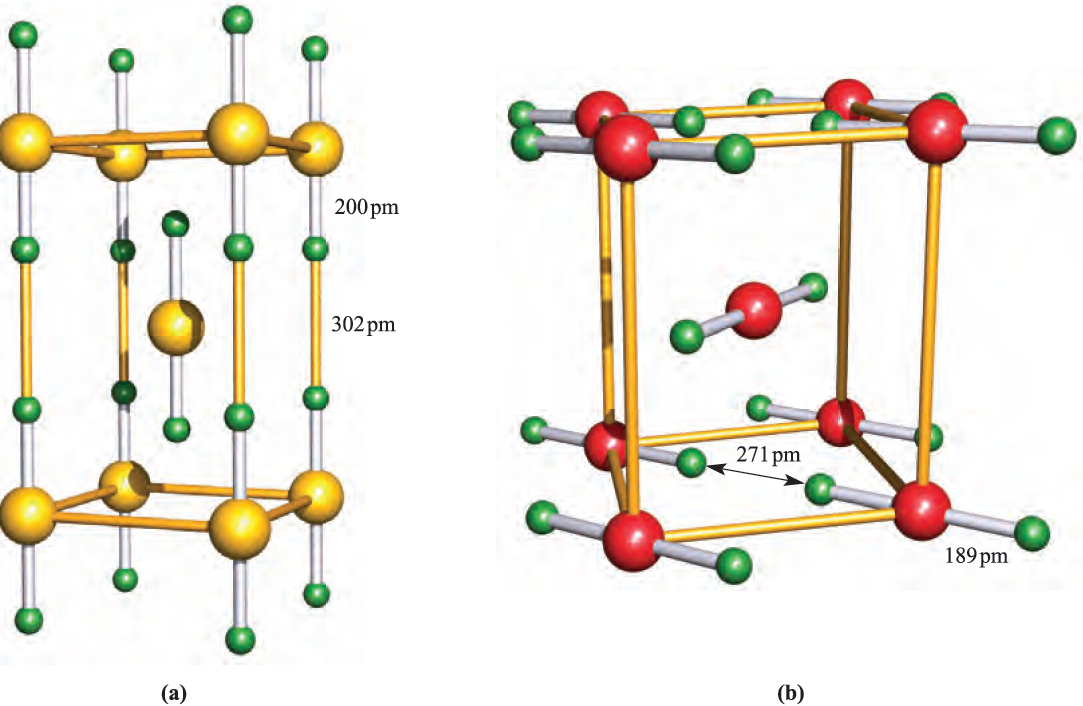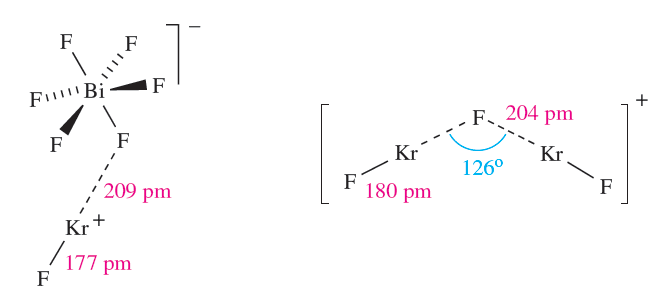
Compounds of krypton and radon
 المؤلف:
CATHERINE E. HOUSECROFT AND ALAN G. SHARPE
المؤلف:
CATHERINE E. HOUSECROFT AND ALAN G. SHARPE
 المصدر:
INORGANIC CHEMISTRY
المصدر:
INORGANIC CHEMISTRY
 الجزء والصفحة:
2th ed p 501
الجزء والصفحة:
2th ed p 501
 5-3-2017
5-3-2017
 1456
1456
Compounds of krypton and radon
The only binary compound containing Kr is KrF2. It is a colourless solid which decomposes >250 K, and is best prepared by UV irradiation of a mixture of Kr and F2 (4 :1 molar ratio) at 77 K. Krypton difluoride is dimorphic. The low-temperature phase, α-KrF2, is isomorphous with XeF2 (Figure 1.1a). The structure of the β-form of KrF2 is shown in Figure 1.1b. The phase transition from β- to α- KrF2 occurs below 193 K. Krypton difluoride is much less stable than XeF2.

Fig. 1.1 Unit cells of (a) XeF2 and (b) β-KrF2 showing the arrangements and close proximity of molecular units. Colour code: Xe, yellow; Kr, red; F, green.
It is rapidly hydrolysed by water and dissociates into Kr and F2 at 298K (∆fHo(298K) = 60.2 kJ mol-1). We have already exemplified the use of KrF2 as a powerful oxidizing agent in the syntheses of [XeF5][AgF4] and [Xe2F11]2[NiF6] (Section 1.1). Krypton difluoride reacts with a number of pentafluorides, MF5 (typically in anhydrous HF or BrF5 at low temperature), to form [KrF][MF6]- (M=As, Sb, Bi, Ta), [KrF][M2F11]- (M=Sb, Ta, Nb) and [Kr2F3][MF6]- (M=As, Sb, Ta). In the solid state, the [KrF]+ ion in [KrF]+[MF6]- (M=As, Sb, Bi) is strongly associated with the anion (e.g. structure 1.1). The [Kr2F3] ion (1.1) is structurally similar to [Xe2F3] (17.5). The oxidizing and fluorinating powers of KrF2 are illustrated by its reaction with metallic gold to give [KrF]+[AuF6]-. Few compounds are known that contain Kr bonded to elements other than F. The reactions between KrF2, RC≡N (e.g. R = H, CF3) and AsF5 in liquid HF or BrF5 yield [(RCN)KrF]+[AsF6]- with Kr_N bond formation, and Kr_O bond formation has been observed in the reaction of KrF2 and B)OTeF5(3 to give Kr)OTeF5(2. Radon is oxidized by halogen fluorides (e.g. ClF, ClF3) to the non-volatile RnF2; the latter is reduced by H2 at 770 K, and is hydrolysed by water in a analogous manner to XeF2 .

(1.1) (1.1)
 الاكثر قراءة في الجدول الدوري وخواص العناصر
الاكثر قراءة في الجدول الدوري وخواص العناصر
 اخر الاخبار
اخر الاخبار
اخبار العتبة العباسية المقدسة


